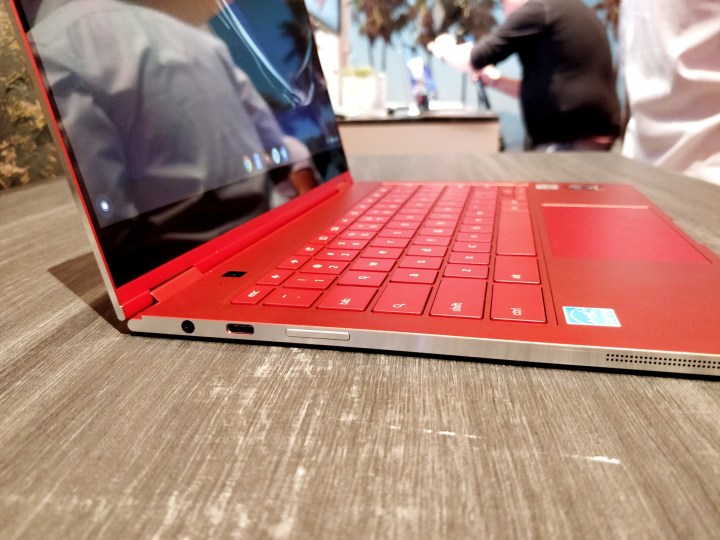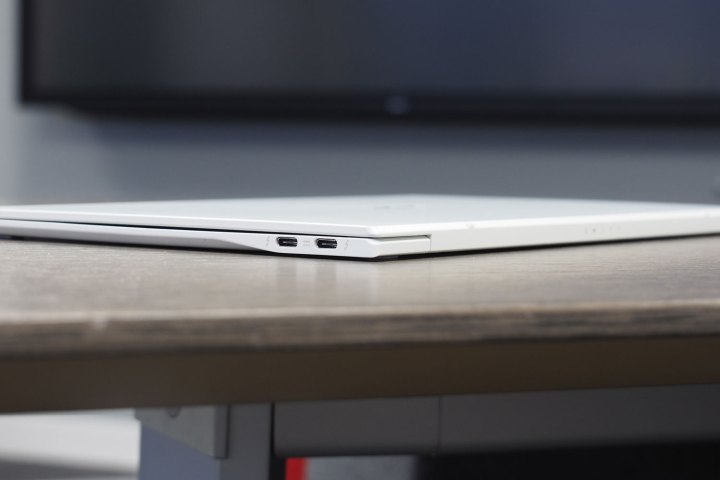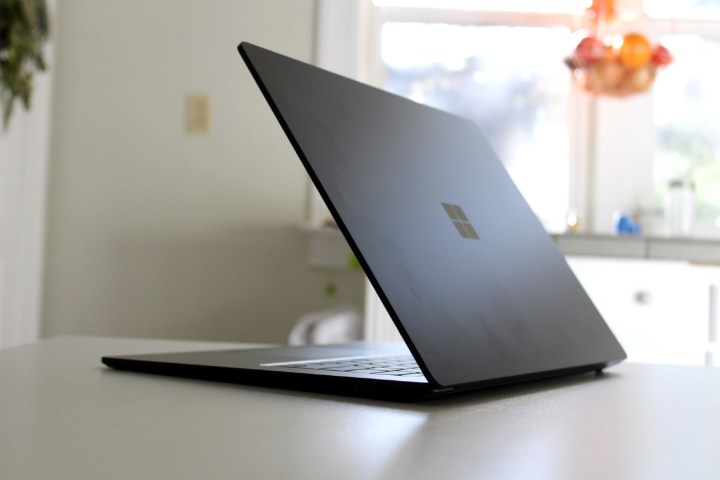The new M2 MacBook Air is incredibly thin — 0.44 inches (11.2mm), to be specific. But numbers don’t quite do it justice. Unless you were to hold this thing in your hands yourself, you might not realize just how thin this really is. But Apple didn’t claim this to be the thinnest laptop ever made — because it’s not.
And while there are a couple that exist, you’ll see quickly that they aren’t exactly one-to-one comparisons.
Samsung Galaxy Chromebook

The thinnest laptop ever made, as far as I’ve been able to determine, is the Samsung Galaxy Chromebook. This fiery red, premium Chromebook came out in 2020, and it has a thickness of just 0.39 inches. As you can see in the photo, that’s just large enough to squeeze in a headphone jack and USB-C port. It was an astounding device to see in 2020, and it remains among the thinnest laptops you can still buy.
This 13-inch laptop is downright tiny, and it’s well-built too. But it’s a Chromebook. And strangely, Samsung hasn’t updated the laptop in the past two years. The company chose to release a sequel in 2021 called the Samsung Galaxy Chromebook 2, but it was a thicker and more budget-friendly laptop. I’m not sure whether or not we’ll ever see a true update to the original Samsung Galaxy Chromebook, but I seriously hope we see Samsung reuse this style of chassis, because in many ways, it felt ahead of its time.
Acer Swift 7

The Acer Swift 7 was the laptop that was the champion of thinness for many years, even before the Samsung Galaxy Chromebook came around. This one also measures in at the same 0.39 inches thick, matching that Chromebook. It’s also incredibly light at 1.96 pounds — one of the lightest laptops you can buy. That’s considerably lighter than the 2.7-pound M2 MacBook Air.
Both of those measurements blow the M2 MacBook Air out of the water — but there’s a catch. First off, the Acer Swift 7 had a number of frustrating compromises, including an awkward touchpad and keyboard, and a strangely positioned webcam.
But the bigger problem? Acer hasn’t updated this model since 2019. That makes it even less of a viable laptop to buy in 2022, especially since it still uses an old 8th-gen Intel processor. A lot of the sacrifices made to ensure that the Acer Swift 7 was the thinnest and lightest of all clearly didn’t convince many buyers it was worth the trade-off.
Like the Samsung Galaxy Chromebook, I don’t know that Acer has plans to update the Swift 7, but clearly it’s taken a break from the design.
Some that are really close

So, while there aren’t many laptops that are quite as thin as the M2 MacBook Air, there are a lot that come close. The half-inch mark is right around where many of the other thin-and-light laptops fall. On the Windows side of things, you have options like the new Dell XPS 13, which comes in at 0.58 inches thick.
There’s also the 13.5-inch Surface Laptop 4, which is slightly thinner than the XPS 13 at 0.57 inches. The Asus ExpertBook B9 falls into a similar size, as does the Zenbook S 13 Flip OLED at 0.59 inches.
Of course, 2-in-1 tablets like the Surface Pro are technically thinner. The Surface Pro 8 is only 0.37 inches thick, but add on the Type Cover keyboard, and you’re back up another 0.2 inches.
It’s entirely possible that I’ve overlooked some laptop here or there, but suffice it to say, the M2 MacBook Air is likely in its own league. Unless you count experimental concept devices like the Craob X, Windows laptops definitely have some catching up to do.


